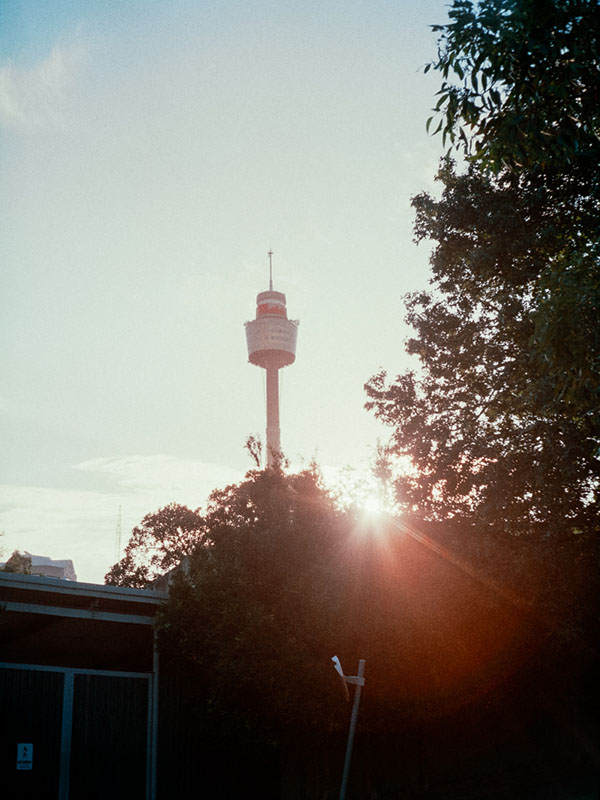FED Mikron – Half or double fun
If you don’t have time to read this review of the FED Mikron, I can read this to you with the Photo Thinking Blogcast! You can find it on most podcast platforms or here.
FED Mikron

The FED Mikron is a little half-frame camera I have been shooting for a bit of fun recently. The general feeling is that half-frame takes a little bit of commitment, as you need to shoot seventy-two frames to finish a standard roll of 35mm. Personally, I feel it does require a change of approach and that it should really release you. I find I start to shoot more freely, not worried as much about finishing a roll.
When I do not get to shoot for a little while, I start to get a bit frustrated. As we all know, life can get in the way, so to overcome this I always have a camera with me, for instance, when I go to work. This way when I have some time to get out into the Sydney sunshine at lunch time, I head straight out. The Mikron is a perfect camera for that, it is small and fairly automatic.

Apart from being in my laptop bag, it also makes its way into my camera bag when I head out for other times too. Six years ago, I had a review of the Olympus EE-2 and my son, Alec, helped we write that one, as he enjoyed shooting that half-frame camera. He was eleven years old back then, he is now seventeen.
I handed the camera to him recently to see what he thought about a similar camera now he is older. He took to it well and I have included some of his photos in this article. Although the Mikron is based on another Japanese camera, it is a Soviet made camera. Even so, he felt it as quite similar and was easily using it within a few minutes.

The FED Mikron is a copy of the Konica EYE. Considering how popular half-frame photography became in Japan, it is not surprising there would be an effort to do the same in the USSR. As a result, many of the cameras are now available directly from ex-Soviet countries.
I have had the Mikron now for two years, and in that time, I have put a few rolls of film through it. Apart from the first one, where I made a user error, I have enjoyed using it. We can have a look at a bit more about the camera then how I got on with it.

RELATED:
- Olympus Pen EE-2 – An 11-year-old’s perspective
- Agfa Optima-Parat – Half Frame Jewel
- Olympus Pen S – The never-ending story
- BelOMO Agat 18K – Plastic Fantastic
History
The story of FED starts in 1926 where a children’s commune was established Kharkov, Ukraine, named after the founder of the Cheka (Soviet secret police), Felix E. Dzerzhinsky. Children orphaned or displaced during the Revolution and associated civil war or from World War One were housed there.
When I first read that during research, I thought that was very weird, but it is because Dzerzhinsky used his power in the secret police to gain government action to set up the commune. Originally the children were trained in shoemaking, locksmithing, sewing and carpentry and paid wages for their work.

In 1932 the factory was being set up to produce cameras based on the Leica A. Three were made that year using lenses from VOOMP who were based in Leningrad. I imagine these would be an ultimate collectable! While they were reported locally as the Soviet Leicas, Leica themselves had moved on to the Leica II. By 1934, production had begun in full swing with FED made lenses.
Now, normally we would go through cameras that FED made through the years, of which there were many. But as we are looking at where the Mikron came from, we will go into another direction. We will look at a Japanese camera called the Konica EYE.

Konica released the EYE in 1964. With a Hexanon 30mm f/1.9 lens, it is a zone focus half-frame camera. It was released in the height of the half-frame popularity, especially in Japan, and while the Olympus cameras were leading the market, it sold very well and was a popular camera.
In 1968 FED released an almost identical copy of the Konica EYE. The FED Mikron (also known as the Micron) is also a zone focus half-frame camera. They were produced for 17 years until 1985, with a reported 120,000 sold.

The Mikron 2 did not really replace the Mikron, as it is a full-frame 35mm rangefinder camera which came out in 1978. It was more like the Konica C35 and was succeeded by the FED 35 and the 50.
Being that the successors were not really the same lineage, the Mikron holds a unique place in camera history, although it is a clone of another camera.

Camera Specifics
The FED Mikron is a small 35mm half-frame viewfinder camera. It has a selenium panel around the lens, which is linked to a metering system to operate the camera. Generally, it is used in Automatic mode, which selects both the aperture and shutter speed.
The built-in lens is a Helios-89 30mm with a maximum exposure of f/1.9. It stops down to f/16 as the minimum aperture. The lens is coated which helps minimise flare. If an aperture is selected, rather than Automatic mode, it will shoot at 1/30 second only.

Shutter speeds range from 1/30 second through to 1/800 second. The film speed is set using the GOST settings from 16-250, which is equivalent to ISO 18-300. Setting is via the thumb wheel on the back of the camera. If the shutter speed calculated is considered too slow by the camera, the speed scale turns red, and the camera will not fire.
The camera itself is straight forward. On top is only the shutter release button, film speed indicator, frame counter, rewind lever and advance lever. Underneath is the film release and tripod socket. Around the lens is where the controls are for selecting mode/aperture and the focusing distance.

Focusing is controlled with the lever around the lens and is estimated actual distance. Minimum focusing distance is 1 metre (3.2 feet).
In the viewfinder it converts the focus distance to a scale shown as a portrait, three quarter portrait, group of people and infinity. That is shown on the left side, on the right side it shows the shutter speed also with a needle. The frame lines include marks for close focus parallax compensation.

Loading film requires the whole back to be removed. Once it is off, the film canister is inserted on the left and the film threaded on the right-hand side. The counter is reset, and a couple of advances are required to move it to the first frame.

The Experience
I found my FED Mikron from a Ukrainian seller on eBay a couple of years ago. I liked the way it had been refurbished with the red leather and had been serviced. It did take quite a while to arrive, but when it did and I took it out of the box and a smile came across my face. This was very much a half frame camera of the era and was a nice little camera in the hand.
As I already had a significant backlog of cameras I wanted to shoot with, combined with the impact on my schedule with the pandemic lockdowns in Sydney, it did not get much love in the first year. Last year I took it off the shelf and put it to work.

When I first went to load film into it, I did have to wrestle with it as the back comes completely off to load. While this is an issue faced with any camera that loads that way, it is still something that can be a little annoying when out in the field. On the plus side, you only do it every seventy-two frames!
I then made my first mistake with this camera. For some reason, which only the darkest recesses of my mind can explain, I believed that by setting it on an aperture it would adjust the speed. It does not. The camera will set itself onto 1/30 second shutter speed on all apertures, as the aperture setting is aimed at using with flash. I did not realise my mistake most of the way through that first film, so I did not get much out of that first roll.

Once I did realise it, the viewfinder information made more sense. The first few rolls were black and white film, specifically Kodak T-Max 100 with the idea that it is a fine grade film. I had read that the lens on this is quite good, and when I got my first rolls from the lab, I could see these were quite good. For little negatives there is quite a lot of detail.
Originally, I was worried on the exposure capability of the selenium meter for the auto exposure. Apart from the ones which I was setting the aperture manually, the negatives came out nicely exposed. I am not sure if this would be the case on a copy that had not been serviced, and to be fair I do not know if the seller had replaced or upgraded the meter on this one. All I can confirm is that this copy of the Mikron exposes very well.

The little Mikron was a constant companion with me. Even when I was not really going to take a camera, I would slip it into a bag. And being set on the Auto mode, it is almost no effort to shoot it.
I moved to using colour film soon after, by loading in Fujifilm Fujicolor C200. Again, the camera performed well. The negatives were not just well exposed, but also quite sharp. Being that you estimate the distance, I was a little unsure, but was pleased with the results. I can see details in the photos which I have struggled with in the past on other half-frame cameras.

The FED Mikron has been a real fun camera to use. I enjoy shooting half-frame as I tend to shoot with a bit more freedom, knowing I have double the frames on a roll of film. Add to that the fact it is a very capable camera, and you have one that makes you reach for it.
I would recommend the Mikron, with the caveat you need to ensure you buy from somewhere they can guarantee it will work given the selenium meter is quite old. It is quite reasonably priced, so that is an added benefit. Just shoot more freely to ensure you get through the seventy-two frames in reasonable time!











Related Links
Alan Duncan of Canny Cameras wrote what he thought with FED Mikron Camera 1 Roll Review.
He then went back for more with FED Mikron Revisited – Back in the USSR.



5 Comments
sonny rosenberg
Interesting to hear about this cool little camera! I had an Olympus Pen F, but when it broke I couldn’t find anyone to repair it. Great shots too! I really enjoyed your article.
Theo
That is a shame as the Pen F is a nice camera.
Thank you! I am really glad you enjoyed the article.
Victor Bezrukov, photographer
Absolutely great results from another stollen (copied) Olympus Pen 🙂 i have very bad experience with half frames. i have to try my Pen (or trip??) again.
Theo
All cloned cameras have pluses and minuses. This one did well by me, as you can see.
Worth a try again, and you never know you might hit the mark with the next one you try.
Victor Bezrukov, photographer
Yes sure, one day i will try. Just have a fewuch more interesting cameras also waiting for my attention;-))))))